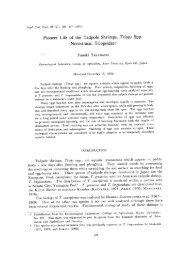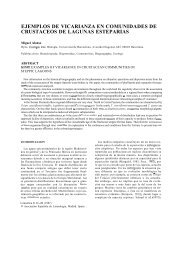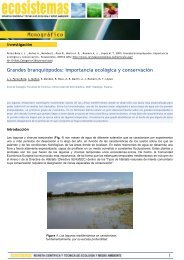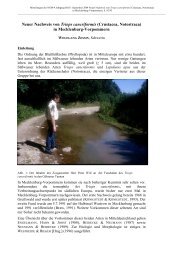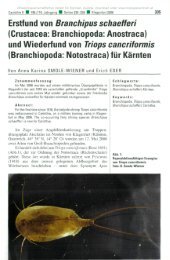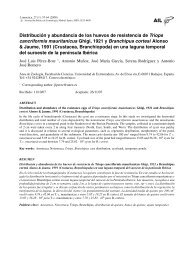Reproductive isolation and genetic differentiation in North American ...
Reproductive isolation and genetic differentiation in North American ...
Reproductive isolation and genetic differentiation in North American ...
You also want an ePaper? Increase the reach of your titles
YUMPU automatically turns print PDFs into web optimized ePapers that Google loves.
128<br />
telson. The number of exposed body r<strong>in</strong>gs (those not<br />
covered <strong>in</strong> dorsal aspect by the carapace) was counted<br />
<strong>in</strong> some specimens. Exposed body r<strong>in</strong>gs <strong>and</strong> total<br />
body length were determ<strong>in</strong>ed only on quiescent but<br />
unanesthetized liv<strong>in</strong>g <strong>in</strong>dividuals.<br />
Many of these characters have been dealt with <strong>in</strong><br />
some detail by L<strong>in</strong>der (1952), <strong>and</strong> we followed his<br />
conventions <strong>in</strong> scor<strong>in</strong>g characters. In summariz<strong>in</strong>g the<br />
body r<strong>in</strong>g data, <strong>in</strong>complete r<strong>in</strong>gs were given a value of<br />
0.5 r<strong>in</strong>g, which was addded to the count of complete<br />
r<strong>in</strong>gs. For legless body r<strong>in</strong>gs, the orig<strong>in</strong> of the most<br />
posterior appendage was scored to the nearest 0.5 r<strong>in</strong>g.<br />
The anterior-most exposed r<strong>in</strong>g was evaluated to the<br />
nearest 0.5 r<strong>in</strong>g on liv<strong>in</strong>g <strong>in</strong>dividuals with the carapace<br />
gently held down aga<strong>in</strong>st the body.<br />
Two meristic variables were derived from body r<strong>in</strong>g<br />
counts: (1) covered body r<strong>in</strong>gs (total body r<strong>in</strong>gs m<strong>in</strong>us<br />
exposed body r<strong>in</strong>gs) <strong>and</strong> (2) abdom<strong>in</strong>al r<strong>in</strong>gs with legs<br />
(total body r<strong>in</strong>gs m<strong>in</strong>us legless r<strong>in</strong>gs m<strong>in</strong>us 11 thoracic<br />
r<strong>in</strong>gs). The ratio of carapace to body length was also<br />
calculated from measured variables. Total body length<br />
measurements <strong>and</strong> exposed r<strong>in</strong>g counts were not made<br />
on either frozen specimens or preserved specimens<br />
s<strong>in</strong>ce the normal tone of the body musculature was<br />
lack<strong>in</strong>g. For these <strong>in</strong>dividuals, the two derived variables<br />
(covered body r<strong>in</strong>gs, <strong>and</strong> carapace ratio) could<br />
not be calculated.<br />
Electrophoretic methods<br />
Prote<strong>in</strong> extracts were prepared by gr<strong>in</strong>d<strong>in</strong>g <strong>in</strong>dividuals<br />
with a Teflon-tipped pestle <strong>in</strong> cold buffer (0.05 m<br />
Tris, pH 7.5) <strong>in</strong> 1 ml per 0.4 g wet weight. Extracts<br />
were then centrifuged <strong>in</strong> an IEC cl<strong>in</strong>ical centrifuge at<br />
approximately 190 RCF for ten m<strong>in</strong>utes at 5 C. Samples<br />
of the supernatant solution were frozen at 70 C.<br />
As needed, frozen extracts were allowed to defrost<br />
on ice <strong>and</strong> subjected to allozyme analysis. Allozymes<br />
were detected with electrophoresis us<strong>in</strong>g 12% starch<br />
gels prepared with one of three buffers <strong>and</strong> sta<strong>in</strong>ed<br />
us<strong>in</strong>g the recipes of Sel<strong>and</strong>er et al. (1971) with occasional<br />
m<strong>in</strong>or modifications. After an <strong>in</strong>itial survey of a<br />
large number of systems, 17 enzymes encoded by 21<br />
presumptive loci were found to be reliable <strong>and</strong> <strong>in</strong>formative.<br />
For four very active enzymes, extracts were<br />
diluted 2:1. For three systems, agar overlays were used<br />
<strong>in</strong> the sta<strong>in</strong><strong>in</strong>g solution. Locus nomenclature, optimal<br />
buffer systems, <strong>and</strong> specifics of the sta<strong>in</strong><strong>in</strong>g procedure<br />
are given <strong>in</strong> Appendix 2. Alleles were scored accord<strong>in</strong>g<br />
to decreas<strong>in</strong>g anodal mobility (with 1 represent<strong>in</strong>g<br />
the most anodal form). After <strong>in</strong>ital scor<strong>in</strong>g of populations,<br />
<strong>in</strong>dividuals represent<strong>in</strong>g the extent of variation<br />
at a locus were reanalyzed to establish allelic identity.<br />
Hierarchical branch<strong>in</strong>g patterns from UPGMA<br />
cluster<strong>in</strong>g of Nei’s <strong>genetic</strong> distance <strong>and</strong> from restricted<br />
maximum likelihood us<strong>in</strong>g a brownian motion model<br />
of <strong>genetic</strong> change were obta<strong>in</strong>ed us<strong>in</strong>g the GENDIST,<br />
NEIGHBOR, <strong>and</strong> CONTML programs of PHYLIP<br />
3.53 (Felsenste<strong>in</strong> 1989). CONTML was run at least<br />
10 times with different <strong>in</strong>put orders us<strong>in</strong>g the global<br />
rearrangement option. Nei’s <strong>genetic</strong> distance is formulated<br />
for an <strong>in</strong>f<strong>in</strong>ite isoalleles model of mutation with<br />
all loci hav<strong>in</strong>g the same mutation rate <strong>and</strong> assumes<br />
that change is by both <strong>genetic</strong> drift <strong>and</strong> mutation.<br />
The brownian motion model of the CONTML program<br />
assumes that change is by <strong>genetic</strong> drift only. The<br />
UPGMA cluster<strong>in</strong>g method assumes that gene substitution<br />
rates are the same <strong>in</strong> each l<strong>in</strong>eage, while the<br />
maximum likelihood method allows for rates to vary<br />
(Nei, 1987; Felsenste<strong>in</strong>, 1985); the comb<strong>in</strong>ed effects<br />
of migration, mutation <strong>and</strong> drift are likely to vary substitution<br />
rates between l<strong>in</strong>eages. Trees were compared<br />
aga<strong>in</strong>st the best tree us<strong>in</strong>g a pairwise z-test of the differences<br />
<strong>in</strong> likelihood on a locus-by-locus basis with<br />
the user-def<strong>in</strong>ed tree feature of the CONTML program.<br />
Results<br />
Prelim<strong>in</strong>ary observations<br />
Heterogeneity among <strong>North</strong> <strong>American</strong> populations of<br />
Triops was <strong>in</strong>dicated <strong>in</strong>itially by morphological analyses<br />
of samples from the San Simon Valley of southeastern<br />
Arizona-southwestern New Mexico. Samples<br />
collected <strong>in</strong> 1981 from various ponds, stock tanks,<br />
<strong>and</strong> roadside ditches over an area about 13 by 32 km<br />
<strong>in</strong> the vic<strong>in</strong>ity of Portal, AZ <strong>and</strong> Rodeo, NM were<br />
scored for several meristic characters, especially the<br />
total number of body r<strong>in</strong>gs <strong>and</strong> the number of legless<br />
body r<strong>in</strong>gs. The salient result was that two dist<strong>in</strong>ct morphotypes<br />
occurred <strong>in</strong> the area, differ<strong>in</strong>g <strong>in</strong> both of the<br />
segmentation variables. One form was characterized<br />
by approximately 36 body r<strong>in</strong>gs with the last six be<strong>in</strong>g<br />
legless; the other form was characterized by about 39<br />
body r<strong>in</strong>gs with the last eight lack<strong>in</strong>g appendages. The<br />
two forms also differed <strong>in</strong> reproductive characteristics.<br />
The shorter-bodied form consisted entirely of females<br />
whereas the longer-bodied was represented by some<br />
populations that were entirely female <strong>and</strong> other populations<br />
<strong>in</strong> which males were present, but generally<br />
<strong>in</strong>frequent (ca 15%).



